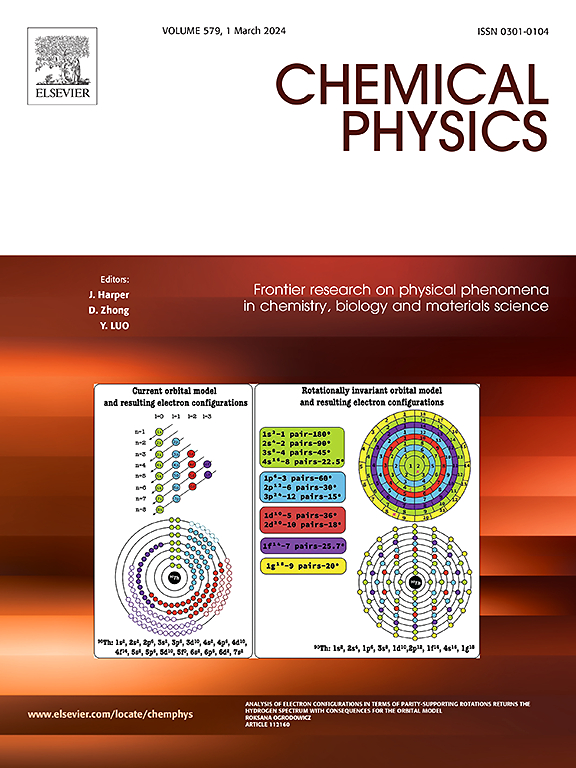Poly(benzyl acrylate) structural and thermodynamic properties in imidazolium-based ionic liquids: A molecular dynamics simulations study
IF 2.4
3区 化学
Q4 CHEMISTRY, PHYSICAL
引用次数: 0
Abstract
Molecular dynamics simulations were performed to investigate the structural and thermodynamic properties of poly(benzyl acrylate) (PBA) in eight imidazolium-based ionic liquids (ILs), each sharing a common cation, 1-ethyl-3-methylimidazolium ([EMIM]+), and different in anions chemistry: acetate [OAc]−, benzoate [Bz]−, bis(trifluoromethane)sulfonimide [NTf2]−, tetrafluoroborate [BF4]−, formate [FRM]−, methyl Sulfate [MeSO4]−, nitrate [NO3]− and hexafluorophosphate [PF6]−. The results demonstrate that both the size and chemical nature of the anions influence the conformation and solvation environment of the PBA chain. In particular, larger or more strongly interacting anions promote polymer swelling, as confirmed by an increase in radius of gyration and end-to-end distance relative to water. Swelling ratios, calculated with respect to water, provide quantitative evidence of anion-specific structural perturbations. The results are further quantified by using the radial distribution functions (RDFs), reduced density gradient (RDG) calculations, and solvent accessible surface area (SASA). The solvation enthalpy (ΔHsolv) and excess molar volume (VEm) of the PBA chain are in accordance with structural changes. Overall, these results provide the effect of IL combinations on the solvation and structural behaviour of the PBA, offering insights relevant for polymer design and IL-based processing.

咪唑基离子液体中聚丙烯酸苄酯的结构和热力学性质:分子动力学模拟研究
通过分子动力学模拟研究了聚丙烯酸苄酯(PBA)在8种咪唑基离子液体(ILs)中的结构和热力学性质,每种离子液体都有一个共同的阳离子,1-乙基-3-甲基咪唑([EMIM]+),以及不同的阴离子化学:醋酸盐[OAc]−、苯甲酸盐[Bz]−、双(三氟甲烷)磺酰亚胺[NTf2]−、四氟硼酸盐[BF4]−、甲酸盐[FRM]−、硫酸甲酯[MeSO4]−、硝酸盐[NO3]−和六氟磷酸盐[PF6]−。结果表明,阴离子的大小和化学性质影响PBA链的构象和溶剂化环境。特别是,更大或更强的相互作用阴离子促进聚合物膨胀,这一点可以从相对于水的旋转半径和端到端距离的增加中得到证实。相对于水计算的膨胀比,提供了阴离子特异性结构扰动的定量证据。通过径向分布函数(rdf)、还原密度梯度(RDG)计算和溶剂可及表面积(SASA)进一步量化了结果。PBA链的溶剂化焓(ΔHsolv)和超摩尔体积(VEm)与结构变化一致。总的来说,这些结果提供了IL组合对PBA的溶剂化和结构行为的影响,为聚合物设计和基于IL的加工提供了相关的见解。
本文章由计算机程序翻译,如有差异,请以英文原文为准。
求助全文
约1分钟内获得全文
求助全文
来源期刊

Chemical Physics
化学-物理:原子、分子和化学物理
CiteScore
4.60
自引率
4.30%
发文量
278
审稿时长
39 days
期刊介绍:
Chemical Physics publishes experimental and theoretical papers on all aspects of chemical physics. In this journal, experiments are related to theory, and in turn theoretical papers are related to present or future experiments. Subjects covered include: spectroscopy and molecular structure, interacting systems, relaxation phenomena, biological systems, materials, fundamental problems in molecular reactivity, molecular quantum theory and statistical mechanics. Computational chemistry studies of routine character are not appropriate for this journal.
 求助内容:
求助内容: 应助结果提醒方式:
应助结果提醒方式:


